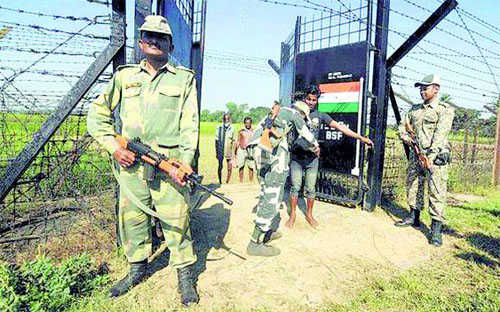KV Prasad
Tribune News Service
New Delhi, May 7
Four decades after India and Bangladesh agreed to solve their complex boundary issues, Parliament today passed the Constitutional Amendment Bill paving the way for transfer of enclaves — 111 Indian enclaves in Bangladesh and 51 Bangladesh — held by each country on other’s land.
The Lok Sabha today cleared the 119th Amendment Bill, now renumbered as Constitutional (100th Amendment), unanimously with 331 members recording their vote on the Bill passed by the Rajya Sabha on Wednesday. It enables operationalisation of the May 16, 1974 Land Boundary Agreement signed between then Prime Ministers Indira Gandhi and Sheikh Mujibur Rehman.
Soon after the passage, Prime Minister Narendra Modi walked across the aisle to thank Opposition leaders, including Congress president Sonia Gandhi, for the support of the Bill, introduced in December 2013 by the Manmohan Singh government but then opposed by the Bharatiya Janata Party.
The introduction of the Bill followed a protocol signed between India and Bangladesh in September 2011 encompassing demarcation of un-demarcated boundary, the territories in adverse possession and identification of exchange of enclaves. The protocol was prepared with support and concurrence of Assam, Meghalaya, Tripura and West Bengal. Modi termed the passage as a historic milestone in bilateral relations saying it reflected the collective will of the nation to build constructive relations with its neighbours.
He later spoke to Bangladesh PM Sheikh Hasina, with country’s High Commissioner Syed Muazzem Ali present in the visitors' gallery. The PM also spoke to other political leaders and chief ministers.
The 111 Indian enclaves in Bangladesh are spread over 17,160.63 acres, while the 51 Bangladesh enclaves in India are over 7,110.02 acres. A joint headcount conducted during July 2011 determined a total population in the enclaves to be around 51,549 — 37,334 in Indian enclaves there and 14,215 in Bangladesh enclaves here. External Affairs Minister Sushma Swaraj received praise from all quarters with some leaders characterising the loss of territory as “notional” without the boundaries contracting.
She said apart from demarcating the boundaries, the step would also help check illegal immigration.
“A solution to the problem of illegal immigration is inherent in this legislation. With the land border now being decided (with the passage of the Bill), the portions where there is no fencing will also get fenced,” she said.
Swaraj said the only issue that remained to be settled with Bangladesh was that of river water sharing, primarily relating to the Teesta, expressing hope the government would try and settle it in a similar manner. The Centre also announced a Rs 3,008-crore package to West Bengal for rehabilitation of people coming to the state from Bangladesh.
The 1974 agreement states people in these areas shall be given the right to stay where they are as nationals of the state to which the areas are transferred.
The protocol
After 1974 Land Boundary Agreement (LBA) signed between then Prime Ministers Indira Gandhi and Sheikh Mujibur Rehman, a protocol was signed between India and Bangladesh on September 6, 2011 to address the outstanding land boundary issues. It encompasses demarcation of undemarcated boundary, the territories in adverse possession and identification of exchange of enclaves. The protocol was prepared with support and concurrence of Assam, Meghalaya, Tripura and West Bengal.
Need for protocol
Article 2 of the LBA, 1974 states the two countries are expected to exchange territories in adverse possession in already demarcated areas. The 2011 protocol provides for redrawing of boundaries so that the adverse possessions do not have to be exchanged. It has dealt with them on an ‘as is where is’ basis by converting de facto control into de jure recognition.
The implementation
The protocol is subject to ratification by the two governments and will enter into force on the date of exchange of Instruments of Ratification. After adoption of the Bill by Indian Parliament, the protocol is likely to be ratified leading to exchange of Instruments of Ratification and its immediate implementation.
Unlock Exclusive Insights with The Tribune Premium
Take your experience further with Premium access.
Thought-provoking Opinions, Expert Analysis, In-depth Insights and other Member Only Benefits
Already a Member? Sign In Now










